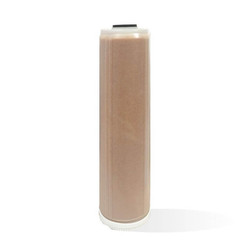CR Spotless Water Systems
CR SPOTLESS FAQ
What is de-ionized water from a Spotless Water Systems proprietary system?
Deionization is a method used most often by laboratories to produce purified water on demand. All naturally occurring water contains dissolved mineral salts. In solution, salts separate into positively-charged cations and negatively-charged anions. Deionization can reduce the amounts of these ions to very low levels through the process of ion exchange. Cations are removed by cation exchange resin. It replaces sodium, calcium, magnesium, and other cations with hydrogen ions (H+). This exchange produces acids that must be removed or neutralized by anion exchange resin. This is also why you must not use the system outside of its operating parameters or you could cause damage to your work surface.
Two general types of anion resin are used for deionization: weak base resin and strong base resin. Weak base resin adsorbs strong acids, while strong base resin exchanges chloride, sulfate, and alkaline anions for hydroxide ions (OH-). The hydrogen ions from the cation exchange process combine with the hydroxide ions from the anion exchange process to form water (HOH or H2O). Because the deionization process is so effective, the water quality is usually measured by the water’s resistance to electric current (in OHM-cm). The end result is purified water that won’t leave mineral deposits – water spots – on your car! The bottom line is that the Spotless Water Systems proprietary system is a blend of filtration and deionization which gets the best results in the industry- ZERO parts per million total dissolved solids.
How does it work?
As the water passes through the filter(s), all the spot-causing calcium's and minerals in the water cling to the resin beads and the purified water continues on to provide spot-free water.
Will soft water extend the life of my resin?
Softened water (potassium or sodium-based) will not extend the life of the resin. The TDS count of the water coming out of the water softener will be (more or less) the same as the water going into your softener and may damage your work surface in cases with high levels of total dissolved solids in the supply water.
When do I need to change the resin?
We recommend replacing the filters when the TDS meter reads above 0 ppm.
Deionized water systems produce 0 ppm water which is physically impossible to leave any spot-inducing residues on your work surface. Filter expiration characteristics are primarily dependent on your local water quality (higher flow rates/resin age can also contribute) and may produce work surface damage above 0 ppm. Nearly every one of our customers do not experience any spots/damage between 1-10 ppm and the vast majority of our customers do not experience spots/damage between 10-20 ppm.
• Use above 0 ppm may cause damage to your work surface.
• You must test your system above 0 ppm with your local source on a test surface to determine your system’s expiration characteristics (i.e. when it starts to leave spots that must be removed by polish).
Will this unit work with well water?
Some well water users have experienced adverse results when using the system downstream of iron removers and/or water softeners. It is best to use the system with your well water before it passes through any stripper/softener and do not use if the Spotless Water Systems unit TDS meter reads any number above 0 (typical resin life exhibits 000 ppm through approximately 90% of resin life so very little capability is lost by this protocol).
Will it remove my wax?
No, it will not remove your wax and the best part is that you do not have to worry about tiny scratches caused by drying with a towel!
Will the resin go bad if I let my system sit for a long time between uses?
Yes, it is possible. After long periods of non-use, there is a possibility that algae can form and foul the resin. If it is going to sit for a long period of time without use (60-90 days) we suggest that you remove the resin cartridges, allow them to drip dry, and dry the inside of the blue housings to prevent algae growth.
-

CR Spotless Bypass Assembly
Our Price: $75.00 -

CR Spotless DI-120 Medium Output Standing System
Our Price: $299.00 -

CR Spotless DIC-10 Medium Output Rolling System
Our Price: $429.00 -

CR Spotless DIC-20 High Output Rolling System
Our Price: $439.00 -

CR Spotless DIW-10 (Medium Output, Wall-Mounted)
Our Price: $389.00 -

CR Spotless DIW-20 (High Output, Wall-Mounted)
Our Price: $409.00 -

-

CR Spotless Replacement Resin Bags (For 20" Cartridge Units) 1-6 Pack
Our Price: $69.00 -

-










